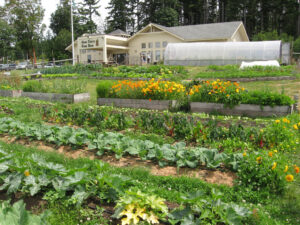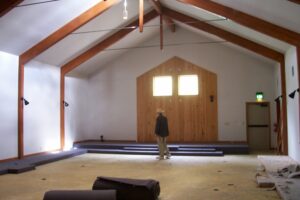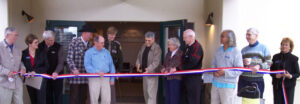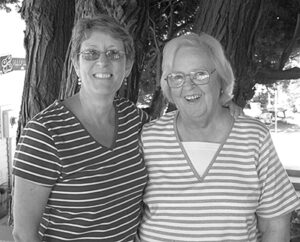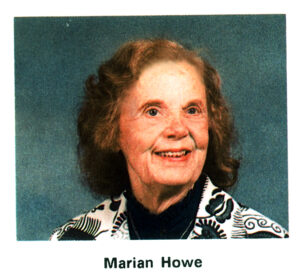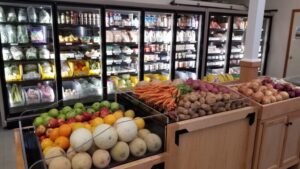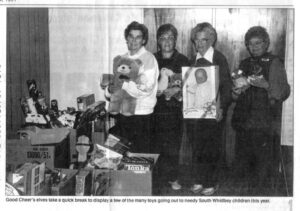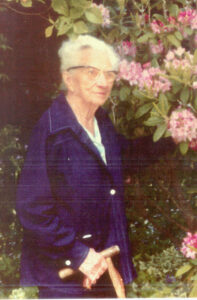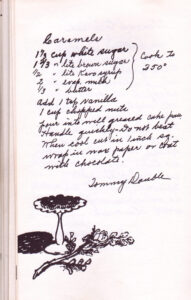Sixty years ago today one of South Whidbey’s earliest and most enduring charities was started: Good Cheer Food Bank & Thrift Stores.
It began near Christmastime in 1962, when a group of friends from various churches came up with an idea to spread some Good Cheer in the tangible form of Christmas food baskets, which also included warm socks and toys for the kids.
The friends contacted the county welfare department for a list of families in need during the holidays, thinking it might be 10 or 20 families in need.
To their surprise they received 120 names of South Whidbey residents — many of them children. A strike at Boeing had contributed to the tough times, but it was also a more rural Whidbey Island.
“People were helping each other back then,” recalled the late Richard Clyde, who spent most of his life in Langley running a garage and became a board member in the late 1980s. “People helped each other because there wasn’t anybody else around.”
Recognizing the need, the group formalized its efforts by forming the South Whidbey Good Cheer Inc. in 1963.
The organization was led by three strong women: President Marian Howe, who had a talent for starting charitable organizations; Vice President Ida deArmand; and Treasurer Hanna Tommy Double, who ran the Langley thrift store for almost 25 years and remained honorary board president for the remainder of her life.
In 1964, the group held its first fund drive. They made a record-setting $61.60.
The organizers were amazed by the generosity of the community, but they offered prudent words in an article in the Whidbey Record after many families had sent in $5.
“While we’re deeply grateful, we want to say such large amounts are not necessary. ‘A dollar donation buys two pairs of socks, and 50 cents buys a game,’” they told Record readers.
In 1965, after two seasons of spreading Christmas joy, the founders submitted an application to become a nonprofit 501(c)(3) — the first of its kind on South Whidbey. At that point, the organization was funded mainly through proceeds from the thrift store that also opened in 1965 in the old post office in Langley next to the Dog House, which is a gallery today.
Double, a retired social worker, ran the thrift store, opening it on Friday afternoons. The store brought in some funds for Good Cheer, but it also served as a help closet for families in need, especially those who were victims of house fires. There wasn’t a Food Bank yet, but Double would hand out food vouchers for the local Star Store.
The late Min Dexter, who became a volunteer in 1978 after retiring from the Star Store, said that the crew at the Star Store sometimes reported that the vouchers weren’t used for nutritional food but for candy and soda pop. Double did not like to hear that, so she started walking clients down to the store.
“You better believe, people started buying good food then,” Dexter said.
Dexter reflected on how much Double would have loved the offerings for clients today at Good Cheer.
“She would have loved the garden, the fresh vegetables,” she said about the garden project that was started in 2009 and provides Food Bank shoppers with seasonal fresh foods.
Good Cheer moved into its best-known location on Anthes Street in Langley in 1969.
With the move to a larger location, an in-house Food Bank was established to handle the increased need and slowly, throughout the 1970s, Good Cheer shifted its focus to feeding people.
Howe and Double led Good Cheer for many years. Double was the face of the Langley Thrift Store until nearly 1980, when she reluctantly retired.
The late Joy McClellan was the executive director from 1981-1996… and she meant business.
When she started out, the Thrift Store made $50 a day on a good day, donations came in slow, yet the need was great, she recalled.
McClellan put her head together with those of other long-time helpers and convinced the board of directors to expand.
“First I was the only paid employee. Then I finally got an assistant,” she said. “Then we talked our board into not renting out the space that Porter Insurance had held and expanded instead. Next, we talked them into building a walk-in freezer. It just kept growing so fast. Upstairs was added in 1992.”
They needed to grow in the early 1980s, she said. Continuing Boeing layoffs affected the community, and the population was growing.
The Food Bank wasn’t by any standard what it is today, McClellan said.
“There were certain things you couldn’t get. We didn’t always have everything. We traded with stores when we needed fresh milk or when somebody had a baby and we needed baby food. Then we’d call around,” McClellan said.
The Thrift Store also wasn’t bringing in much, said long-time volunteer the late Marilyn Thomas.
“We never made any more than $20 a day. If we did, it felt like we did something big,” she said.
“Boy, if we had $100 then we had really done something. And if somebody came in with a big donation of items, all the volunteers would hurry to be first in line to sort. We were a long way from the piles that you find at the place in Bayview,” she said, referring to the state-of-the-art distribution center at Good Cheer’s Bayview site.
Good Cheer’s Executive Director from 2002 to 2017, Kathy McLaughlin (now McCabe), oversaw 15 years of expansion and developed innovative ways to help create a hunger-free community on South Whidbey.
Additional Thrift Stores were added, “Good Cheer Two” in 2002, first near Clinton Food Mart plaza, and then it was moved to Ken’s Korner in 2007.
After a successful capital campaign, the Bayview facility was purchased and renovated in 2007. The Item Donation and Distribution Center moved in first, followed by the construction of a refrigerator and freezer addition… then the Food Bank was created to look like a small grocery store. That, along with an innovative food points system allowed people to shop with dignity and select food more targeted to their needs.
The Langley Thrift Store was renovated. An onsite community garden was begun, followed by the opening of the Big Acre garden behind the old Bayview School. Partnerships with local farmers and grocery stores were established and have continued to be strengthened.
The present three-person Executive Director team of Karen Korbelik, Stephanie Turco, and Lissa Firor has continued to oversee improvements.
Last year solar panels were placed on the roof, and this year after a successful capital campaign, a new entrance was built. It contains offices and a community connection program where shoppers can meet with representatives of local nonprofits to tackle the root causes of food insecurity.
What began as a simple act of community goodwill now serves as a model program for rural communities. Happy birthday, Good Cheer!
Looking for a homemade Christmas candy recipe?
You may want to make this recipe (below) for caramels by one of South Whidbey Good Cheer’s founders, Hanna “Tommy” Double. The recipe is from the original Good Cheer cookbook produced in the 1960’s as a fundraiser.
Tommy was born in 1883 on a family farm in Pennsdale, Pennsylvania. The third of 10 children, she was taught compassion at an early age.
“My Dad had a beautiful farm called the ‘Home of the Friendless’,” she recounted in a 1983 article in the South Whidbey Record on the eve of her 100th birthday. The farm drew people who were down on their luck and they were made to feel welcome there.
It was her father, she said, who had the most influence on her life — a life dedicated to helping people. It is believed that Tommy was a social worker in New York City before moving to Whidbey Island in 1957 upon her retirement.
“My work all my life was for the guy that needed something,” Double was quoted in the article. It was that spirit that led her to help found South Whidbey Good Cheer with other local residents.
According to those who knew her, she was a tireless woman who managed the thrift store single-handedly for a few years while the nonprofit was being developed and volunteers enlisted to help.
“It was really more of a help closet then,” recalled the late Good Cheer volunteer Min Dexter in a 2007 article in Good Cheer’s newsletter. “There were a lot of house fires in those days (1960s) and people would come to the thrift store for items that they needed to replace.”
Good Cheer was originally begun as a holiday charity distributing food baskets and children’s clothing and presents. It wasn’t until the early 1970s that it served as an in-house food bank.
“Before then, Tommy would hand out vouchers so that people could shop for their groceries at the Star Store,” Dexter said.
“Most people were responsible with what they bought, but a few bought candy and soda, so Tommy started to accompany them to make sure they bought basic nutritious food with the vouchers,” she said.
“Oh, yes,” confirmed the late Jo Driftmier who had been a longtime volunteer, “there was no buying fancy stuff like raisin bread while Tommy was watching. It was basic whole wheat bread. No treats.”
“Tommy was a tiny woman, but what a tour-de-force she was,” recalled the late Judy Yeakel, who advised the food bank on commodities distribution in the 1970s. “She really kept Good Cheer going in those days,” Yeakel is quoted in the same article.
“We had just moved here in 1971 and then my husband was laid-off from Boeing. I remember walking in to Good Cheer and Tommy being very sweet and saying in effect, ‘Right now you need a little help and we’re glad to be here for you, but someday you’ll be back on your feet again and will be able to come back and help others.’”
“It was both a reassurance that the tough times wouldn’t last and a gentle way of recruiting a future volunteer,” she said with a chuckle.
“She was there all the time,” recalls Mark Myres, who moved near the Langley Thrift Store when he was 12. “I used to think she actually lived there,” he said.
“Tommy was a sweet, dear woman. She was always kind to me and I thought of her as a sort of grandmother who would help me find socks or parts for my short-wave radio set.,” he said.
“It was amazing that she could see anything through her thick coke-bottle lens glasses, or that she got around as well as she did leaning on two canes,” he added.
Tommy kept running the Langley thrift store until her mid-90s when her health declined. Still, she wanted to keep working.
The sad task of asking her to retire fell to the late Robert Porter, then President of Good Cheer, and who until the Porter Building was opened ran his insurance office in what is now the corner specialty item salesroom of the Langley Thrift Store.
“Tommy Double was quite a gal. She was a strong-willed woman, who when she wanted to do something, would do it.
“By the time I became Good Cheer Board President in the 70s, Tommy’s eyesight was so bad that she depended on someone else to drive her into Langley every day.
“Her health began to fail and she started to have fainting spells in the store. It broke my heart to have to insist that she retire, but I came up with the idea of naming her Good Cheer Board President Emeritus and made sure that someone brought her to the monthly Board meetings. She was treated like a Super Queen Bee and loved it,” he said.
Leona Potvin, Tommy’s right-hand volunteer, then took over as manager.
Tommy, who had been a resident at the Island Harbor Care Center in Freeland the last several years of her life, died in November 1984, just five months shy of her 101st birthday.
————————
Tommy Double’s Caramels
1-1/3 cup white sugar
1-2/3 cup light brown sugar
1/2 cup lite Karo syrup
2 cups evaporated milk
1/3 cup butter
Cook the ingredients above to 250 degrees (use a candy thermometer).
Add 1 teaspoon vanilla
1 cup chopped nuts
Pour into a well-greased cake pan. Handle quickly — do not beat.
When cool, cut into one-inch squares (or rectangles). Wrap in waxed paper or coat with (melted) chocolate.
—– Tommy Double

